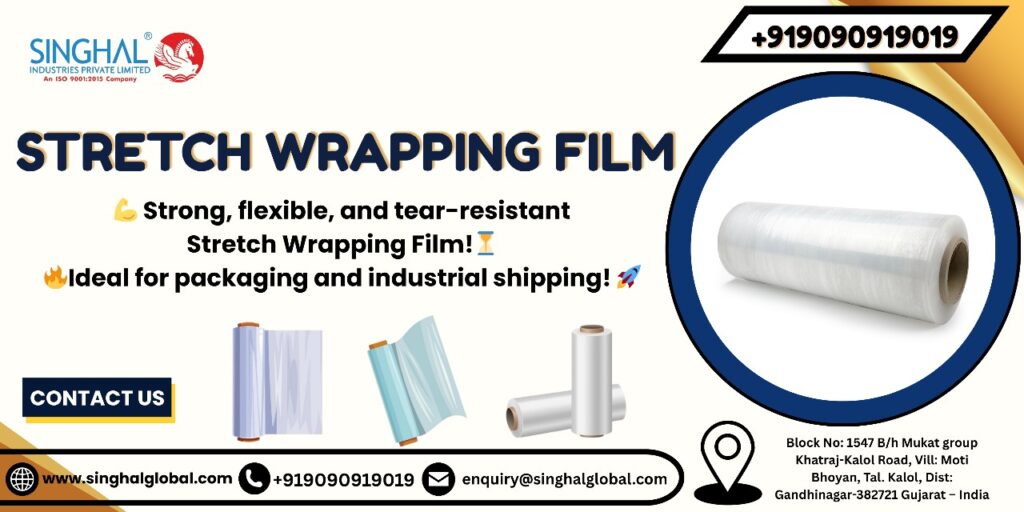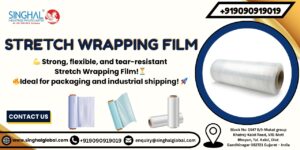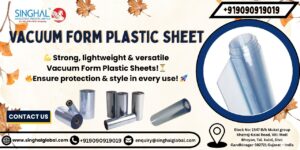Visit the nearest cold store or packaging plant and you’ll find one thing that performs a lot of lifting heavy-stretch film. It’s everywhere, covering pallets of frozen vegetables as well as securing boxes of dairy goods, even preventing bottles of drinks from falling over.
Despite being thin and virtually invisible, stretch films are an invisible guardian for food logistics and cold storage. It’s the unnoticed hero who ensures that our food stays solid, safe and in good condition all the way from factory flooring all the way to the tables at our dinner table.
The demand for frozen and packaged food items is increasing, knowing the basic principles of this material and what it does more than ever. Let’s peel off the layers to see the reasons why Stretch film roll are vital in this cold and challenging setting.
Why Stretch Film Matters in Cold Storage
Cold storage facilities aren’t a joke. Imagine warehouses that are cooled to -20°C or even lower, in which every item from ice cream to frozen fish has to be handled without breaking the chain of cold.
In the freezing climate equipment becomes slower and workers are required to wear gloves, and items get slippery when covered in frost. In the absence of stretch films, pallets could slide, move or collapse in the course of movement. One fall could destroy the value of thousands of food.
Stretch film rolls solve this problem beautifully. It clings to the products, thereby locking them to form a stable, solid unit. The elasticity keeps everything secure but allows for some movement of the pallet in transit.
I once went to an exporter of fruits in Maharashtra where employees employed the stretch-film to wrap mango boxes that were headed towards Europe. The cold room was extremely cold. You could smell your breath. But, the workers swiftly wrapped each pallet and the pallet remained in place. There was not a single piece of the material that moved in the midst of the forklift’s movement across the floor. This is the strength of a simple plastic sheet.
Stretch Film in Food Packaging Units
When cold storage needs toughness and grit, food packaging units require more than that: clarity, cleanliness and hygiene.
Fresh food items, ready-to-eat meals, bakery items, and drinks typically go through automated packaging lines. Stretch film roll is used to cover boxes, trays, or bottles. It does not just hold the products in place but also seals away dirt, dust and moisture.
The best part? It’s fast. Machines can wrap up dozens of packs in a minute. The transparent film lets buyers know what they’re purchasing. Imagine the neatly wrapped tray of apples you find at the supermarket. Its clear plastic keeps the apples fresh and attractive and stops them from rolling off.
In these settings the Stretch film price per kg becomes a significant aspect. Food manufacturers go through tonnes of it every week. A small difference in the cost of stretch film rolls per kilo can add up to a huge amount of savings over the course of a year Therefore, businesses are always trying to balance cost and the performance.
Cold Temperatures and Material Science
The stretch film that is used for cold storage needs to withstand harsh conditions. Normal plastic is brittle once frozen, however, specialized stretch films are made to remain flexible even in temperatures that are below freezing.
These films typically have multi-layer structures, like a sandwich of various polymers, each with its own unique characteristics like cling, flexibility, and puncture resistance.
It’s interesting to think about it. A thin plastic wrap is able to stand up against the cold, vibration, and rough handling. It’s similar to the superhero cape of logistics.
The Economics Behind the Wrap
Logistics is a small-margin industry. Even a tiny amount of savings on packaging can add up to a lot. This is why purchasing teams are obsessed with the cost of stretch film per kilo. Certain companies purchase jumbo stretch film rolls and then load them onto automatic wrapping equipment, which lowers the cost of labor. Others choose pre-stretched films so that they utilize less material per pallet.
There have been heated discussions in warehouses regarding whether converting to a less expensive film could pose a risk to the safety of the load. It’s a delicate balance: go too low and the film tears easily, go too high-end and the Stretch film roll price per kg. However, using the correct film can reduce losses on products, which typically surpasses the film’s expense. A damaged pallet during transport could result in food spoilage and loss of revenue; therefore, investing in a good film can be a smart choice for economics.
Looking Ahead: Greener Stretch Films
One omission in this story is difficult to overlook: stretch film is plastic. The waste of plastic is a major problem. The positive side is that producers are creating recyclable and biodegradable versions. A lot of stretch film producers are now offering films made of recycled materials that can still work well in cold temperatures. Some manufacturers even have closed-loop systems, where they take old films and recycle them to make new films.
It’s not the perfect solution, but it’s making progress. Think about if each pallet that is in cold storage was wrapped in a film that didn’t end up contaminating oceans. This is where industry leaders are trying to get to, and it gives me some optimism.
Conclusion
Stretch film may not be attractive, but it’s the foundation of cold packaging and storage for food items. It protects products from damage, is less likely to cause food waste, reduces costs, and helps keep supply chains in motion. Behind every tidy pallet in a frozen warehouse, there’s a worker who stowed it in a tight wrap, a buyer who determined the cost of a stretch film roll per kilogram, and a machine that turned the roll into the size of a huge plastic cocoon. We don’t often notice it, but perhaps we ought to. Because, without that thin film of stretch, the entire food logistics system may completely collapse.
Frequently Asked Questions (FAQs)
Q1. What sizes does stretch-film come in?
Stretch film is available in various sizes (commonly between 300mm and 600mm) in different thicknesses (12 up to 35 micrometers). They can be small hand rolls or massive machine rolls, based on the purpose for which you are using them.
Q2. What is the shelf-life on stretch film?
Typically, stretch films have a shelf-life of 12 to 18 months when kept in a cool and dry area away from sunlight. Extreme cold or heat can decrease its elasticity with time.
Q3. What number of layers are required to ensure Stability?
It’s dependent on the load’s shape and weight; generally 3 to five layers of film are wrapped around the pallet. The heavier or more unstable loads may require more layers or a more durable film.
Q4. Is stretch film safe to use for food packaging?
Yes, food-grade stretch films are made to be safe and non-toxic for food contact. They help keep food safe but still allow the ability to see.
Q5. Who is the largest manufacturer of stretch films?
There are a number of major stretch film producers around the world with a focus on India, the USA, China, and India. India’s industry for packaging is growing rapidly and local businesses are now leading exporters as well.









